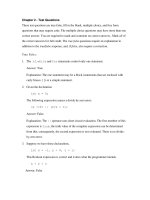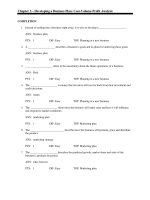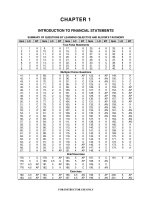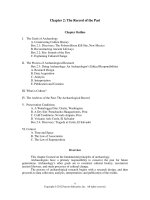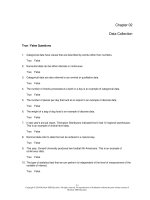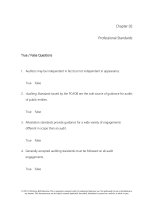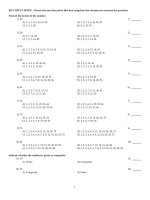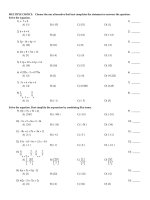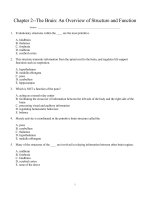Communication principles for a lifetime 5th edition beebe test bank
Bạn đang xem bản rút gọn của tài liệu. Xem và tải ngay bản đầy đủ của tài liệu tại đây (433.45 KB, 34 trang )
Test Bank
for
Beebe/Beebe/Ivy
Communication: Principles for a Lifetime
Fifth Edition
Prepared by
Leonard Edmonds
Arizona State University
Boston Columbus Indianapolis New York San Francisco Upper Saddle River
Amsterdam Cape Town Dubai London Madrid Milan Munich Paris Montreal Toronto
Delhi Mexico City Sao Paulo Sydney Hong Kong Seoul Singapore Taipei Tokyo
Copyright © 2013, 2010, 2007 by Pearson Education, Inc.
All rights reserved. Manufactured in the United States of America. The contents, or parts thereof,
may be reproduced with Communication: Principles for a Lifetime, Fifth Edition, by Steven A.
Beebe, Susan J. Beebe, and Diana K. Ivy provided such reproductions bear copyright notice, but
may not be reproduced in any form for any other purpose without written permission from the
copyright owner.
To obtain permission(s) to use material from this work, please submit a written request to
Pearson Education, Inc., Permissions Department, One Lake Street, Upper Saddle River, New
Jersey 07458, or you may fax your request to 201-236-3290.
1 2 3 4 5 6 7 8 9 10—OPM—14 13 12 11
ISBN-10: 0-205-85018-9
www.pearsonhighered.com
ISBN-13: 978-0-205-85018-1
TABLE OF CONTENTS
Test Bank Chapter 1: Foundations of Human Communication..................................... 2
Test Bank Chapter 2: Self Awareness and Communication ........................................ 18
Test Bank Chapter 3: Understanding Verbal Messages................................................ 33
Test Bank Chapter 4: Understanding Nonverbal Messages ........................................ 47
Test Bank Chapter 5: Listening and Responding ........................................................... 62
Test Bank Chapter 6: Adapting to Others: Diversity and Communication .............. 78
Test Bank Chapter 7: Understanding Interpersonal Communication ....................... 92
Test Bank Chapter 8: Enhancing Relationships............................................................ 107
Test Bank Chapter 9: Understanding Group and Team Performance..................... 122
Test Bank Chapter 10: Enhancing Group and Team Performance .......................... 137
Test Bank Chapter 11: Developing Your Presentation ................................................ 152
Test Bank Chapter 12: Organizing and Outlining Your Presentation...................... 167
Test Bank Chapter 13: Delivering Your Presentation .................................................. 182
Test Bank Chapter 14: Speaking to Inform ..................................................................... 198
Test Bank Chapter 15: Speaking to Persuade ............................................................... 211
1
Copyright © 2013, 2010, 2007Pearson Education Inc. All Rights Reserved.
Test Bank Chapter 1: Foundations of Human Communication
1.1 Multiple Choice
1.1-1
The study of communication is important because of which of the following?
a. We can become more employable
b. We can improve our interpersonal relationships
c. We can improve our health
d. All of the above are reasons to study communication
4–7
Page Ref:
Answer: d. All of the above are reasons to study communication
1.1-2
The process of acting upon information is the definition of _____.
a. intrapersonal communication
b. communication
c. interpersonal communication
d. human communication
7
Page Ref:
Answer: b. communication
1.1-3
In the textbook, the primary distinction between the definition of communication
and human communication involves _____.
a. acting upon information
b. managing relationships
c. interacting simultaneously
d. making sense out of the world
7
Page Ref:
Answer: d. making sense out of the world
1.1-4
When we interpret, which of the following may be involved?
a. sight and sound
b. thoughts, feelings and words
c. touch, smell and taste
d. all of these can be included in interpreting experiences
7
Page Ref:
Answer: d. all of these can be included in interpreting experiences
1.1-5
According to the textbook, in its broadest sense, communication is the process or
which of the following?
a. Thinking about information.
b. Sending information.
c. Acting on information.
d. Making sure grammar is correct.
7
Page Ref:
Answer: c. Acting on information.
2
Copyright © 2013, 2010, 2007Pearson Education Inc. All Rights Reserved.
1.1-6
According to the textbook, human communication is _____.
a. is the process of making sense out of the world and sharing that sense with others
by
creating meaning through the use of verbal and nonverbal messages.
b. is the process of making sense out of the world and sharing that sense with others
by
creating meaning through the use of verbal messages.
c. is the process of making sense out of the world and sharing that sense with others
by
creating meaning through the use of nonverbal messages.
d. is the process of making sense out of the world and sharing that sense with others
by
creating meaning through the use of intrapersonal messages.
7
Page Ref:
Answer: a. is the process of making sense out of the world and sharing that sense with
others by
creating meaning through the use of verbal and nonverbal messages.
1.1-7
Kimesha listens privately to her iPod on the way to campus and wears her
university T-shirt to class for her Friday lab. Kimesha is expressing her thoughts
and feelings through which of the following?
a. music
b. art
c. clothing
d. hair-do
7
Page Ref:
Answer: c. clothing
1.1-8
Symbols can be
a. words
b. sounds
c. gestures
d. all of these
8
Page Ref:
Answer: d. all of these
1.1-9
Dr. Johnson posts an announcement on her course web page that she is
administering an exam on Thursday. On Thursday, she is surprised to find that
over half of her students did not prepare for the exam or did not study the correct
material. This misunderstanding illustrates what aspect of communication
competence?
a. The message should be ethical.
b. Emotions are expressed unintentionally.
c. Communication is a linear process.
d. The message should achieve its intended effect.
9
Page Ref:
Answer: d. The message should achieve its intended effect.
1.1-10
Another word for decoding is _____.
a. interpretation
b. speaking
c. creating
d. noise
12
Page Ref:
Answer: a. interpretation
3
Copyright © 2013, 2010, 2007Pearson Education Inc. All Rights Reserved.
1.1-11
Noshin is listening to Leah tell a story about what happened in class yesterday.
The two are engaging in which actions?
a. Noshin is encoding and Leah is decoding
b. Noshin and Leah are both encoding
c. Noshin is decoding and Leah is encoding
d. Noshin and Leah are both decoding
12
Page Ref:
Answer: c. Noshin is decoding and Leah is encoding
1.1-12
Prior to class, Ralitza received a phone message alerting her to call home
immediately. As a result of receiving this message, Ralitza is unable to focus on
the class discussion. Which component of the communication process does this
describe?
a. receiver
b. feedback
c. noise
d. context
13
Page Ref:
Answer: c. noise
1.1-13
The terms feedback and context are introduced in which of the communication
models?
a. communication as action
b. communication as interaction
c. communication as reaction
d. communication as transaction
13–14
Page Ref:
Answer: b. communication as interaction
1.1-14
On the day Janet was scheduled to give her speech, her class was relocated into
an auditorium. Janet couldn’t quite overcome the feeling of isolation she felt as
she spoke to her twenty classmates in a room that could seat 500. Which of the
following elements is most responsible for Janet’s reaction?
a. feedback
b. context
c. information source
d. channel
13–14
Page Ref:
Answer: b. context
1.1-15
Jenny is speaking to Madina about her ideas for a speech. While Jenny is
speaking, Madina simultaneously shakes her head and has a puzzled look on her
face. Jenny notices this response and stops and explains her ideas in another
way. This example is most closely related to which model of communication?
a. communication as action
b. communication as feedback
c. communication as interaction
d. communication as transaction
14–15
Page Ref:
Answer: d. communication as transaction
1.1-16
The model of communication referred to as ‘human communication as action’ may
be summarized with the phrase _____.
a. communication takes place when messages are sent and received
b. communication takes place when messages are exchanged
4
Copyright © 2013, 2010, 2007Pearson Education Inc. All Rights Reserved.
c. communication takes place when meanings are created and maintained
d. communication takes place when human beings are affected by each other
15
Page Ref:
Answer: a. communication takes place when messages are sent and received
1.1-17
Billie received a series of email messages from an address with which she was
not familiar. She tried to track down the sender, but could not determine who
he/she was. The sender of these emails to Billie was using which characteristic of
mediated communication?
a. anonymity
b. personal appearance
c. distance
d. time
e. relationship
15
Page Ref:
Answer: a. anonymity
1.1-18
When you use Facebook to send a message to a friend, you are utilizing _____
communication.
a. mass
b. moderated
c. presentational
d. mediated
e. printed
15
Page Ref:
Answer: d. mediated
1.1-19
The fact that we communicate with others nonverbally even when we may not
intend to do so demonstrates that communication is
a. inescapable.
b. irreversible.
c. emphasizing content.
d. emphasizing relationships.
18–19
Page Ref:
Answer: a. inescapable.
1.1-20
Gilberto makes a negative comment about Kristen’s new haircut. He quickly
recants saying, “I’m sorry, Kristen. You know I didn’t mean it.” Unfortunately,
Kristen still feels hurt. This example demonstrates that communication is _____.
a. inescapable
b. intentional
c. irreversible
d. complicated
19
Page Ref:
Answer: c. irreversible
1.1-21
Dean Barnlund suggested that when we communicate with one other person,
there are at least six other “people” involved. This statement suggests that
communication is _____.
a. relational
b. complicated
c. governed by rules
d. inescapable
19–20
Page Ref:
Answer: b. complicated
5
Copyright © 2013, 2010, 2007Pearson Education Inc. All Rights Reserved.
1.1-22
According to communication scholar Wiio, which of the following is/are true about
communication?
a. communication cannot fail
b. if a message can be understood in different ways, it will be understood in just the
way that does the least harm
c. there is never anyone who knows better than you what you meant by your
message
d. the more communication there is, the more difficult it is for communication to
succeed
20
Page Ref:
Answer: d. the more communication there is, the more difficult it is for communication to
succeed
1.1-23
The aspect of communication that focuses on WHAT is said, including new
information, ideas, and suggested actions, is referred to as _____.
a. content
b. relational
c. intention
d. implication
e. context
21
Page Ref:
Answer: a. content
1.1-24
The aspect of communication that focuses on HOW something is communicated,
and refers to emotions, attitudes, and power, is describing the _____.
a. content of the message
b. context of the message
c. interaction dimension
d. relationship dimension
21
Page Ref:
Answer: d. relationship dimension
1.1-25
All communication involves rules that define appropriate behavior. What factors
influence these rules?
a. The people involved.
b. The placement of the people involved.
c. The culture in which people are communicating.
d. The length of the message.
e. Both A and C
21
Page Ref:
Answer: e. Both A and C
1.1-26
Chinh knows that when he visits his friend, Rob, he must always call ahead. Rob
has never directly told Chinh to do this. This example illustrates a(n) _____.
a. explicit rule
b. implicit rule
c. content rule
d. relational rule
21
Page Ref:
Answer: b. implicit rule
6
Copyright © 2013, 2010, 2007Pearson Education Inc. All Rights Reserved.
1.1-27
Which of the following is an example of intrapersonal communication?
a. talking to a friend about biology class
b. telling your roommate about a personal problem
c. mentally reviewing what you have to do that day
d. ordering a pizza over the phone
22–23
Page Ref:
Answer: c. mentally reviewing what you have to do that day
1.1-28
Sondra is conscious of her tendency to be soft-spoken and withdrawn in
communication situations. Based on this example, what characteristic of a
competent communicator does Sondra have?
a. She effectively interprets verbal messages.
b. She appropriately adapts her communication.
c. She is aware of her own communication.
d. She listens and responds thoughtfully.
22–23
Page Ref:
Answer: c. She is aware of her own communication.
1.1-29
Language consists of _____.
a. symbols and sounds
b. rules and sounds
c. context and rules
d. symbols and rules
23
Page Ref:
Answer: d. symbols and rules
1.1-30
According to the textbook, which of the following statements is most accurate
about nonverbal communication?
a. Cultural differences have little impact on the way we interpret nonverbal messages.
b. People are more likely to believe your verbal communication than your nonverbal.
c. Nonverbal messages have a clear-cut beginning and ending point.
d. Nonverbal messages may be intentional or unintentional.
23–24
Page Ref:
Answer: d. Nonverbal messages may be intentional or unintentional.
1.1-31
Which of the following statements is accurate concerning listening?
a. Psychological noise helps make effective listening possible.
b. Listening is primarily a passive task.
c. Listening is the easiest communication skill to develop.
d. Effective listeners are other-oriented.
24
Page Ref:
Answer: d. Effective listeners are other-oriented.
1.1-32
Kara’s friend states that she did not understand what Kara meant by her previous
statement. Kara restates her message by giving an example that is personally
relevant to her friend. Kara’s behavior best illustrates which of the principles of
communication?
a. Effectively using and interpreting nonverbal messages.
b. Appropriately adapting your messages to others.
c. Being aware of your communication.
d. Effectively adapting to the context of the communication.
25–26
Page Ref:
Answer: b. Appropriately adapting your messages to others.
7
Copyright © 2013, 2010, 2007Pearson Education Inc. All Rights Reserved.
1.1-33
Which of the following is included in the definition of interpersonal
communication as discussed in the textbook?
a. managing relationships
b. impersonal
c. one-to-many
d. common goal
26
Page Ref:
Answer: a. managing relationships
1.1-34
Which of the following is an attribute of interpersonal communication?
a. Interpersonal communication is linear.
b. Interpersonal communication is a monologue.
c. Interpersonal involves responding to people’s roles.
d. Interpersonal communication involves mutual influence.
26–27
Page Ref:
Answer: d. Interpersonal communication involves mutual influence.
1.1-35
Which of the following could best be described as an example of impersonal
communication?
a. Asking the teller at the bank to cash a check.
b. Discussing skydiving with your English professor after class.
c. Reviewing your notes for your history exam.
d. Talking to your best friend about your job interview.
26–27
Page Ref:
Answer: a. Asking the teller at the bank to cash a check.
1.1-36
Frank and Jesse are involved in a team project at work. During a break from the
team meeting, Frank and Jesse move to the hallway and discuss what it is the two
of them wish to bring up in the next session. This conversation between Frank
and Jesse would be considered what?
a. Small group communication
b. A presentation
c. Mediated communication
d. Egocentric communication
e. A dyad
27
Page Ref:
Answer: e. A dyad
1.1-37
The textbook describes small group communication as a transactional process
among three to fifteen people who
a. meet often.
b. work in the same context.
c. are “in sync” with each other.
d. share a common goal.
27
Page Ref:
Answer: d. share a common goal.
1.1-38
Which of the following is an example of presentational communication?
a. a radio talk show
b. Oprah Winfrey delivers a graduation speech.
c. A faculty awards committee meets to select scholarship recipients.
d. muttering to yourself as you study your French
27–28
Page Ref:
Answer: b. Oprah Winfrey delivers a graduation speech.
8
Copyright © 2013, 2010, 2007Pearson Education Inc. All Rights Reserved.
1.1-39
Ted is a communication researcher working at a local hospital. He studies how
patients and their nurses and doctors communicate. He also studies how the
hospital communicates about its new weight loss campaign, “Drop It!” Ted is
directly involved in researching which area of communication?
a. team communication
b. small group communication
c. health communication
d. mediated communication
28
Page Ref:
Answer: c. health communication
1.1-40
Aristotle’s definition of rhetoric includes _____.
a. the process of discovering the available means of persuasion in a given situation.
b. the use of gimmicks to get what you want.
c. another term for public communication.
d. the process of learning about language and symbols.
28
Page Ref:
Answer: a. the process of discovering the available means of persuasion in a given
situation
1.2 True/False
1.2-1
Personnel managers cite oral communication skills as a top factor in helping
graduating college students obtain employment.
5
Page Ref:
Answer: true
1.2-2
When seeking employment, it is good to know that the top-ranked factor that
human resources professionals desire in applicants is the ability to have
experience in resume writing.
5
Page Ref:
Answer: false
1.2-3
According to research cited in the textbook, communication plays a role in
maintaining your emotional, but not your physical health.
6
Page Ref:
Answer: false
1.2-4
According to the textbook, a characteristic of competent communication is to
achieve a common understanding of the message.
9
Page Ref:
Answer: true
1.2-5
The other-oriented perspective is essential for a message to achieve its desired
effect.
9
Page Ref:
Answer: true
1.2-6
The Pascal quotation, “There are truths on this side of the Pyrenees, which are
falsehoods on the other,” suggests that there is not a universal code of ethics that
is followed by all cultures.
9–11
Page Ref:
Answer: true
1.2-7
Brad is angry with Angie, so while she tells him why she wants to go out to a
specific restaurant for dinner, he sits perfectly still and makes no eye contact with
9
Copyright © 2013, 2010, 2007Pearson Education Inc. All Rights Reserved.
her. In these ways, Brad is able to confuse Angie by not sending any feedback to
her.
12
Page Ref:
Answer: false
1.2-8
Someone who is distracted by the thought of an upcoming exam and misses the
professor’s advice on how best to study is experiencing literal noise.
13
Page Ref:
Answer: false
1.2-9
According to the textbook, the key problem with the “communication as action”
model of communication is that it overlooks the various channels of
communication.
13
Page Ref:
Answer: false
1.2-10
The “communication as transaction” model fails to take into account the
simultaneous nature of communication.
14–15
Page Ref:
Answer: false
1.2-11
When Filiberto returns home from his classes, he finds that there are three emails
from his friend Paolo that were sent at various times of the day. These emails
illustrate that mediated communication is synchronous.
16
Page Ref:
Answer: false
1.2-12
The relationship dimension of a message offers cues about the amount of power
and control the speaker feels toward the other person involved in the
communication.
21
Page Ref:
Answer: true
1.2-13
The relationship aspect of communication is usually explicit in a person’s verbal
messages.
21
Page Ref:
Answer: false
1.2-14
A nonverbal message may contradict a person’s verbal message.
24
Page Ref:
Answer: true
1.2-15
You spend more time listening than performing any other communication activity.
24
Page Ref:
Answer: true
1.2-16
Verbal messages are more believable than nonverbal messages.
24
Page Ref:
Answer: false
1.2-17
A dyad must have at least three people interacting.
27
Page Ref:
Answer: false
1.2-18
According to the textbook, an important aspect of a successful group is having a
sense of belonging among its members.
10
Copyright © 2013, 2010, 2007Pearson Education Inc. All Rights Reserved.
Page Ref:
Answer: true
27
1.2-19
Bert, Ernie, and Oscar are in a serious discussion about their highway trash
pickup contract. This is an example of dyadic communication.
27
Page Ref:
Answer: false
1.2-20
Presentational communication occurs when a speaker addresses a gathering of
people to inform, persuade, or entertain.
27
Page Ref:
Answer: true
1.3 Short Answer
1.3-1
List and explain the three reasons why we study communication as outlined in the
text.
4–7
Page Ref:
Answer: It is important to study communication in order to improve employability. In fact,
a survey shows that personnel managers consider communication skills the top factor in
graduating college students obtaining employment. Communication can also help
improve our relationships whether they be work-related, friendships, romantic, or with
family members. Good communication can lead to strong, lasting relationship. Finally,
communication can improve physical and emotional health. The lack of close
relationships can lead to illness or even death. Good communication can lead to strong
relationships that can help us combat stress.
1.3-2
What is the definition of human communication as discussed in the textbook?
7
Page Ref:
Answer: Human communication is defined in the book as making sense out of the world
and sharing that sense with others through verbal and nonverbal messages. We make
sense of the world conveyed to us through our senses and attempt to share that
meaning with other people. Human beings use both verbal and nonverbal means to
share their understandings.
1.3-3
What three criteria should be used to judge communication competence?
8–9
Page Ref:
Answer: The message should be understood and it was intended. The message should
achieve the intended effect of the communicator. The message should be ethical.
1.3-4
Explain the concept that meaning is co-created.
8, 11
Page Ref:
Answer: According to the textbook, all individuals involved in the communication
process shape how a message is understood by drawing on their own experiences to
make sense of the message. The meaning comes from the hearts and minds of both the
sender and receiver of the message rather than just one or the other.
1.3-5
Explain the criteria for ethical communication by defining ethics and
explaining some sources for ethical views.
9–11
Page Ref:
Answer: Because communication can be used for either honorable or dishonorable
objectives, the authors of the textbook feel that effective communication should go
beyond being understood and accomplishing one’s goals. So, an effective message
should also be ethical. Ethics are the beliefs, values, and moral principles by which we
determine what is right or wrong. Precepts for ethical behavior are communicated
through philosophy and religion as well as professional codes of ethical behavior.
11
Copyright © 2013, 2010, 2007Pearson Education Inc. All Rights Reserved.
1.3-6
Explain the concept of feedback. What are some possible sources for feedback?
13
Page Ref:
Answer: The communication as interaction model adds the component of feedback
which is the response to the message. Without feedback, communication is less likely to
be effective. Feedback can be intentional (a verbal response such as a question or
paraphrase or nonverbal response such as applause or a head nod) or unintentional
(such as blushing or a yawn or sigh).
1.3-7
Explain and give an example of what is meant by the term ‘context’.
13–14
Page Ref:
Answer: Context is the environment in which a communication interaction takes place. It
may either be a physical environment, such as the room you are in, a historical
environment, such as your past relationships and culture, or a psychological
environment, which would be what is going on in the minds of the communicators.
1.3-8
Explain the basic assumption of the “human communication as transaction”
model.
14–15
Page Ref:
Answer: This model looks at communication as the creation of meaning. In addition to
the components of the earlier and simpler models, it assumes that communicators
interact simultaneously, adapting constantly to each other so that the meaning for the
transaction is created together. This is a contrast to the earlier models, which assumed
meaning is transferred from one person to another.
1.3-9
Briefly list and explain the three communication contexts discussed in the text.
26–28
Page Ref:
Answer: Interpersonal communication is simultaneous communication with another
person in an attempt to mutually influence one another in order to manage relationships.
Small-group communication are when communication occurs between a group of three
to fifteen people who share a common purpose, feel a sense of belonging, and exert
influence upon one another. Presentational communication occurs when a speaker
addresses a large audience in person.
1.3-10
Define a dyad.
27
Page Ref:
Answer: A small group should contain these elements: (1) verbal and nonverbal
message transactions (2) approximately 3 to 15 people (3) a common purpose or goal
(4) a sense of belonging among group members (5) the ability of group members to exert
influence upon one another.
1.4 Completion
1.4-1
The beliefs, values, and moral principles by which we determine what is right or
wrong are called our _____.
9
Page Ref:
Answer: ethics
1.4-2
The pathway through which messages are sent is the _____.
12
Page Ref:
Answer: channel
1.4-3
The written, spoken, and unspoken elements of communication to which we
assign meaning are called _____.
12
Page Ref:
Answer: messages
1.4-4
Thoughts, worries, and feelings that distract us from the communication process
12
Copyright © 2013, 2010, 2007Pearson Education Inc. All Rights Reserved.
are called _____.
13
Page Ref:
Answer: psychological noise
1.4-5
The communication as interaction perspective added two dimensions to the study
of communication that were not a part of the communication as action model.
Those two are _____, which is a response to a message, and _____, which is the
communication environment.
13
Page Ref:
Answer: feedback/context
1.4-6
_____ communication often occurs when a time delay occurs between the sending
of an email message and the receipt or reading of that message.
16
Page Ref:
Answer: asynchronous
1.4-7
Rules that are not specifically spelled out are _____ rules.
21
Page Ref:
Answer: implicit
1.4-8
A followable prescription that indicates what behavior is obligated, expected,
preferred, or prohibited in a specific situation is a _____.
21
Page Ref:
Answer: rule
1.4-9
Communication that occurs within yourself is referred to as _____ communication.
22
Page Ref:
Answer: intrapersonal
1.4-10
To be _____ is to consider the needs, motives, desires, and goals of our
communication partners while still maintaining our integrity.
24
Page Ref:
Answer: other-oriented
1.4-11
The process of using symbols to influence or persuade others is _____.
28
Page Ref:
Answer: rhetoric
1.5 Matching Questions
1.5-1
Match these terms to the definitions given below:
a. Response to a message.
b. A process of translating ideas,
feelings, and thoughts into a code.
c. Encompasses the physical and
psychological environment.
d. Person who decodes a message and
attempts to make sense out of what the
source has encoded.
e. Originator of a thought or emotion
who puts it into a code that can be
understood by a receiver.
f. Interference with the accurate
reception of the message.
g. Pathway through which messages
are sent.
Feedback
Encoding
Context
Receiver
Source
Noise
Channel
13
Copyright © 2013, 2010, 2007Pearson Education Inc. All Rights Reserved.
h. The process of interpreting ideas,
Decoding
feelings, and thoughts that have been
translated into a code.
12–13
Page Ref:
Answer: a. Feedback/b. Encoding/c. Context/d. Receiver/e. Source/f. Noise/g.
Channel/h. Decoding
1.5-2
Match these terms to the definitions given below:
a. The process of creating meaning
Group communication
among three to fifteen people who
share a common goal.
b. Part of the message that offers cues
Relationship dimension
about the emotional attitudes of the
speaker.
c. Communication that occurs when a
Presentational communication
speaker addresses a large audience in
person.
d. The process of interacting
Interpersonal communication
simultaneously with another person
and mutually influencing each other,
usually for the purpose of managing
relationships.
e. Unspoken communication that is the
Nonverbal communication
primary means for conveying feelings
and attitudes.
f. Process of communicating that
Impersonal communication
responds to people’s roles rather than
who they are as individuals.
g. Communication that occurs within
Intrapersonal communication
yourself.
h. Communication that is carried out
Mediated communication
using some channel other than face to
face.
15–27
Page Ref:
Answer: a. Group communication/b. Relational dimension/c. Presentational
communication/d. Interpersonal communication/e. Nonverbal communication/f.
Impersonal communication/g. Intrapersonal communication/h. Mediated communication
1.5-3
Match these terms to the definitions given below:
a. Effectively use and interpret verbal
Principle Four
messages.
b. Listen and respond thoughtfully to
Principle Five
others.
c. Appropriately adapt messages to
Principle One
others.
d. Be aware of your communication
Principle Two
with yourself and others.
21
Page Ref:
Answer: a. Principle Four/b. Principle Five/c. Principle One/d. Principle Two/a.
1.6 Essay Questions
1.6-1
In a well-developed essay, explain why it is useful to study interpersonal
communication. Use examples taken from the life of a typical college student to
14
Copyright © 2013, 2010, 2007Pearson Education Inc. All Rights Reserved.
illustrate the points you make.
6
Page Ref:
Answer: Studying interpersonal communication may help you improve your relationships
with family, friends, and colleagues, and improve your own physical and mental health.
The communication of our family helps to shape our self-concept and influences how we
interact with others. If our parents have been patient and supportive, we will likely have a
positive self-concept and treat others with patience and support. Outside of our family,
developing friendships and loving relationships with others is a major source of
satisfaction and happiness for the individual. Friends and lovers can help us weather
stressful situations and provide guidance in times of decision. Being able to establish
supportive and caring relationships with others is vital to our overall well-being. Even
though we do not always have a choice in our professional relationships, we can help to
improve those relationships to make our jobs easier. Effective interpersonal
communication can help us manage conflict, improve problem solving, and generate a
less stressful environment. We also know that loneliness can have disastrous effects on
a person’s health. People who feel alone and alienated are more prone to stress related
diseases, depression, and even death. Strong relationships with caring partners can
improve one’s physical and mental health.
1.6-2
Discuss how communication can be an important factor in the improvement of our
health
6–7
Page Ref:
Answer: Social support systems, created through communication, tend to make a
difference in our quality of like and our health. Stress is managed more effectively
through our intimate relationships and our relationships with our good friends,
contributing to our emotional and our physical health. The separation for a romantic
partner through death or divorce can contribute to serious illnesses, while opportunities
for intimacy and stress-managing communication diminish without companions and close
friends. Clearly, having a social support system through effective communication can
lead to improved health.
1.6-3
Compare and contrast the three models of communication presented in the
textbook: communication as action, communication as interaction,
communication as transaction. Explain the basic components of each model and
identify how each model is different and/or more realistic than the other models.
11–15
Page Ref:
Answer: The communication as action model is comprised of a source or the originator
of a thought or emotion who encodes a message and sends it to the receiver via a
channel. This message may encounter noise or interference which may prevent clear
understanding. The receiver decodes the message by trying to make sense out of it.
Interpretation of the message may be affected by literal or psychological noise. The
communication as action model is flawed because it views communication as a linear
input/output process. It does not take into account that the receiver may or may not
understand the message the way the source intended. Essentially, the source transfers
the message into the receiver without regard for the receiver’s level of understanding.
The model does not account for the complexity of the communication process. The
communication as interaction model is similar to the communication as action model, but
it adds in the concepts of feedback and context. Feedback is the response to a
message. Context is the physical and psychological communication environment. Unlike
the communication as action model, this model allows the receiver to respond to
message to ensure that mutual understanding has occurred. While this model appears to
take into account all the factors in communication, it fails to acknowledge the fact that
communication is a simultaneous process with both senders and receivers
simultaneously encoding and decoding messages rather than a step by step linear
process. The communication as a transaction model again takes into account all the
concepts of the previous two models but also acknowledges that we are constantly
15
Copyright © 2013, 2010, 2007Pearson Education Inc. All Rights Reserved.
reacting to what our communication partner is saying. In other words, we send and
receive messages simultaneously. Both communication partners work together to clarify
and co-create meaning. This is the most accurate description of human communication.
1.6-4
Discuss how personal appearance might impact mediated communication
differently than it might in a face-to-face conversation.
15–16
Page Ref:
Answer: In mediated communication, we can only guess what the person looks like on
the “other end” of an email or what he/she is doing, unless there is a camera to see them
as they communicate. We cannot make judgments about the person based on
appearance. We cannot see what the sender is physically doing while emailing. Thus,
there are not the possibilities of contradictions between the verbal and the nonverbal
communication that is going on. When reading an email, we can only read the verbal
message; there are no nonverbals to go along with, support, or contradict those words.
1.6-5
Explain the five fundamental principles of human communication outlined in your
text and give an example of each principle.
21–26
Page Ref:
Answer: (1) Principle one deals with being aware of your communication with yourself
and others. Intrapersonal communication or communication with self impacts our
communication with others. Competent communicators are aware of their
communication with others and with self, and they are able to monitor their behavior
rather than reacting mindlessly. For example, Kara is aware that her tendency to use
animated facial expressions and gestures is often overwhelming to some people.
(2) Principle two encompasses being able to effectively use and interpret verbal
messages. Verbal messages include words that form a language. It is important that as
communicators, we can use words that create an accurate meaning in the minds of our
listeners, and that we can accurately interpret the words of others. This results in shared
meaning. An example of verbal communication include using words such as, “I love you,”
to convey a message to a listener.
(3) Principle three is effectively using and interpreting nonverbal messages. Nonverbal
communication is communication other than written and spoken language. Nonverbal
communication is the primary way we communicate feelings, is more believable than
verbal communication, and is often difficult to understand because it is continuous. An
example of nonverbal communication would be making eye contact with someone to
convey an interest in talking to him/her.
(4) Principle four is listening and responding thoughtfully to others. This principle takes
into account that both the receiver and the source bear the responsibility for
communication. Listening is an active process that requires an other-oriented
perspective. An example of effective listening would be listening to a friend tell you about
her problem and attempting to see the problem from her perspective.
(5) Principle five is appropriately adapting messages to others. Adapting deals with
tailoring your communication to reach your communication goals while maintaining your
integrity and honesty. It means that you must take your audience into account. For
example, in presenting your position in a persuasive presentation, you relate the
information to your audience’s experiences and background, but you do not provide
information that is false to persuade your audience.
1.6-6
Explain what it means to be “other-oriented” and why you should be otheroriented.
24
Page Ref:
Answer: According to the text, when you are other-oriented, you consider the needs,
motives, desires, and goals of your communication partners while still maintaining your
own integrity. The choices you make in both forming the message and selecting when to
share it should take into consideration your partner’s thoughts and feelings.
Communication can be more effective when we are less self-focused and consider the
16
Copyright © 2013, 2010, 2007Pearson Education Inc. All Rights Reserved.
thoughts and feelings of the other person.
1.6-7
Compare and contrast the differences between impersonal and interpersonal
communication.
26–27
Page Ref:
Answer: Interpersonal communication is a particular type of human communication that
focuses on simultaneous interaction between people in relationships in which they
attempt mutually influence one another, usually for the purpose of managing their
relationship. For example, a discussion between best friends about the state of their
friendship would be an interpersonal exchange. Impersonal communication is the type of
communication that occurs when we treat others as objects or that responds only to the
role the person is playing. When you order pizza, you are communicating on an
impersonal level.
17
Copyright © 2013, 2010, 2007Pearson Education Inc. All Rights Reserved.
Test Bank Chapter 2: Self Awareness and Communication
2.1 Multiple Choice
2.1-1
Danielle is able to observe and reflect upon her own mental states, thus exhibiting
a. Self-awareness
b. Self-image
c. Self-expectations
d. Self-fulfilling prophecy
36
Page Ref:
Answer: a. Self-awareness
2.1-2
Jenny sees herself as a caring person. She communicates this perception of
herself to a career counselor; therefore, the counselor recommends that she enter
the field of nursing. Jenny’s interaction with the counselor demonstrates what
dimension of Jenny’s self-awareness?
a. Material self-awareness
b. Subjective self-awareness
c. Objective self-awareness
d. Symbolic self-awareness
36–37
Page Ref:
Answer: d. Symbolic self-awareness
2.1-3
According to Maslow’s framework on the process of becoming self-aware, a
person whose communication skills are effective and are second nature is
working at which level?
a. Unconscious incompetence
b. Conscious incompetence
c. Conscious competence
d. Unconscious competence
37
Page Ref:
Answer: d. Unconscious competence
2.1-4
Juan has recently noticed that when he works with his group on the group project,
they dismiss his suggestions. He has no idea how to go about getting them to
listen to his ideas. In which level of self-awareness is Juan with regard to his
communication skills?
a. Unconscious incompetence
b. Conscious incompetence
c. Conscious competence
d. Unconscious competence
37
Page Ref:
Answer: b. Conscious incompetence
2.1-5
Merielle’s self-concept or inner identity will
a. change dramatically as she ages.
b. change quite a lot as she meets new people.
c. remain relatively stable.
d. be directly changed as her family changes.
38
Page Ref:
Answer: c. remain relatively stable
2.1-6
Alfonso is very tall and thin and cannot seem to add any muscle, although he
works out in the gym four days every week. While at the gym, Alfonso compares
18
Copyright © 2013, 2010, 2007Pearson Education Inc. All Rights Reserved.
his lack of muscle with the muscles of other men who work out at the gym.
Alfonso’s concern with this discrepancy is attributed to his focus on
a. material self.
b. subjective self.
c. objective self.
d. symbolic self.
38–40
Page Ref:
Answer: a. material self
2.1-7
Maria does not feel confident with her academic abilities in Calculus class;
however, she feels at ease with her abilities in her drawing class. This example
illustrates which of the following?
a. Self
b. Self-concept
c. Self-image
d. Self-fulfilling prophecy
38
Page Ref:
Answer: c. Self-image
2.1-8
Brian expresses his dislike for Chinese food. Brian’s dislike demonstrates which
component of self-concept?
a. Belief
b. Attitude
c. Value
d. Behavior
38
Page Ref:
Answer: b. Attitude
2.1-9
Jaclyn thinks life exists on other planets. This example illustrates which
component of self-concept?
a. Belief
b. Attitude
c. Value
d. Behavior
38
Page Ref:
Answer: a. Belief
2.1-10
Athena thinks that killing animals for food is morally wrong. Athena’s convictions
would be which of the following?
a. An attitude
b. A belief
c. A value
d. A behavior
38
Page Ref:
Answer: c. A value
2.1-11
Jason spends nearly two hours each day calling and texting his family as well
as using Facebook to contact friends. According to James’ theory of the self,
Jason is taking care of his
a. material self.
b. social self.
c. spiritual self.
d. emotional self.
40
Page Ref:
Answer: b. social self
19
Copyright © 2013, 2010, 2007Pearson Education Inc. All Rights Reserved.
2.1-12
Which of the following statements most accurately describes the social self?
a. You are represented by the things you own.
b. You are what you have.
c. You have different selves in relation to different people.
d. You attempt to answer for yourself, “Why am I here?”
40
Page Ref:
Answer: c. You have different selves in relation to different people.
2.1-13
Natasha contemplates her place in the universe, but not from a religious
standpoint. Natasha is exploring which component of self?
a. Material self
b. Social self
c. Spiritual self
d. Emotional self
40
Page Ref:
Answer: c. Spiritual self
2.1-14
Aisha noticed at work that Vincent and Michelle kept asking her advice on office
procedures. Soon, she began to see herself as competent and knowledgeable.
Which of the following statements best describes the means by which Vincent and
Michelle influenced Aisha’s self-concept?
a. Communication with others
b. Association with groups
c. Roles we assume
d. Self-labels
40–41
Page Ref:
Answer: a. Communication with others
2.1-15
Jose was raised in a Cuban-American community. Although he had many college
friends from other co-cultures, he proudly maintained his Cuban roots by
sprinkling his speech with Spanish phrases. In addition, he enjoyed sharing
examples of cultural norms from his family and neighborhood in his
communication class. These examples show which kind of influence on Jose’s
self-concept?
a. Communication with others
b. Association with groups
c. Roles we assume
d. Self-fulfilling prophecy
41
Page Ref:
Answer: b. Association with groups
2.1-16
When Maury is asked to describe herself, her first response is that her friends
often call her an overachiever. This describes her _____.
a. avowed identity
b. assumed role
c. ascribed identity
d. aspect of her spiritual self
41
Page Ref:
Answer: c. ascribed identity
2.1-17
As Ellen was nearing graduation, she thought back over her college career.
Although she had wanted to be more involved in extra-curricular activities, she
had focused more on her studies and tended to describe herself first as a student.
What aspect of the formation of self-concept does this describe?
a. Assumed role
20
Copyright © 2013, 2010, 2007Pearson Education Inc. All Rights Reserved.
b. Cyber selves
c. Avowed identity
d. Association with groups
41
Page Ref:
Answer: c. Avowed identity
2.1-18
When thinking in terms of assumed roles and self-concepts, men describe
themselves in terms of which of the following?
a. Gifted
b. Powerful
c. Vulnerable
d. A and B only
42
Page Ref:
Answer: a. Self-reflexiveness
2.1-19
Priscilla feels that she is unattractive and unlovable following a break-up with her
boyfriend. Prior to this incident, Priscilla had a healthy view of her worth. Priscilla
experienced a decrease in which of the following?
a. Self-reflexiveness
b. Self-concept
c. Self-esteem
d. Self-consciousness
42
Page Ref:
Answer: c. Self-esteem
2.1-20
The assessment of your worth or value as reflected in your perceptions of such
things as your skills, abilities, appearance and talents is _____.
a. self-esteem
b. self-expectations
c. material self
d. ascribed identity
42
Page Ref:
Answer: a. self-esteem
2.1-21
Cindi has lost a good deal of self-esteem because she does not see herself to be
as pretty as the girls on television. This may be largely due to which of the
following?
a. self-analysis
b. communication with others
c. images in the media
d. groups
43
Page Ref:
Answer: c. images in the media
2.1-22
The statement, “I’m not intelligent because my roommate makes better grades
than I do,” illustrates which of the following?
a. Self-fulfilling prophecy
b. Social comparison
c. Self-expectations
d. Social expectations
43
Page Ref:
Answer: b. Social comparison
2.1-23
The term for the psychological and emotional characteristics of individuals that
cause them to be masculine, feminine, or androgynous is
a. sex
21
Copyright © 2013, 2010, 2007Pearson Education Inc. All Rights Reserved.
b. gender
c. ethnicity
d. culture
43
Page Ref:
Answer: b. gender
2.1-24
Andrew had plans to be married by the age of 25; however, he turned 30 and was
still unmarried. He concluded that he was incapable of maintaining a healthy
relationship. Andrew’s self-esteem was impacted by which of the following?
a. Gender differences
b. Social comparison
c. Self-expectations
d. Self-fulfilling prophecy
43–44
Page Ref:
Answer: c. Self-expectations
2.1-25
People can become stressed out because their self-expectations are
a. reframed
b. too clear
c. too low
d. unrealistic
44
Page Ref:
Answer: d. unrealistic
2.1-26
The idea that what we believe will occur in the future is likely to come true
because we believe it will come true is called_____.
a. social comparison
b. self-expectation
c. self-consciousness
d. self-fulfilling prophecy
44–45
Page Ref:
Answer: d. self-fulfilling prophecy
2.1-27
Christa experienced extreme anxiety about the thought of giving a presentation to
her classmates. On the day of the presentation, she repeated in her mind
statements such as, “You are well-prepared.” and “You have valuable information
to share with your audience.” What technique was Christa using to boost her selfesteem?
a. Positive self-talk
b. Visualization
c. Reframing
d. Losing your baggage
46
Page Ref:
Answer: a. Positive self-talk
2.1-28
Aaron was asked to give a speech to the incoming freshmen about the advantages
of serving in student government. He had never given a speech before and was
very nervous. A speech professor suggested that in addition to practicing, he
could picture himself delivering the speech successfully, and receiving favorable
feedback from his audience. Which method did the professor recommend to help
Aaron manage his communication apprehension?
a. Visualization
b. Positive self-talk
c. Reframing
d. Surrounding himself with positive people
47
Page Ref:
22
Copyright © 2013, 2010, 2007Pearson Education Inc. All Rights Reserved.
Answer: a. Visualization
2.1-29
Lakesha received a lower grade than she expected on her first history paper. At
first she was upset but then she realized that the paper was only 10% of her total
grade for that class. Which method did she use in enhancing her self-esteem?
a. Visualization
b. Reframing
c. Self-fulfilling prophecy
d. Social comparison
47
Page Ref:
Answer: b. Reframing
2.1-30
Paul and Patty are able to talk to one another candidly about one another’s faults
and strengths. Their self-esteem is improved because of which of the following
factors?
a. They are reframing their experiences.
b. They surround themselves with positive people.
c. They have developed an honest relationship.
d. They engage in positive intrapersonal communication.
47–48
Page Ref:
Answer: c. They have developed an honest relationship.
2.1-31
Edgar wants to develop s healthy self-esteem, so he engages in which of the
following?
a. Compare yourself to others
b. Place a label on yourself based upon one incident
c. Mentally rehearse all possible scenarios, positive and negative
d. Surround yourself with positive people
48
Page Ref:
Answer: d. Surround yourself with positive people
2.1-32
Larry grew up in a family in which his mother and father were constantly fighting
and insulting each other. Their divorce was especially messy and mean. The poor
quality of their relationship caused Larry to avoid commitment in a loving
relationship for many years. Larry finally decides that he can no longer allow his
feelings about love and marriage to be colored by his parents’ failures. Which
technique for improving self-esteem did Larry use?
a. Developing honest relationships
b. Visualizing
c. Positive messages
d. Losing your baggage
48–49
Page Ref:
Answer: d. Losing your baggage
2.1-33
Perception involves _____.
a. the arousal of our senses
b. making generalizations about people
c. mentally rehearsing future communication events
d. looking at experiences from a different perspective
49
Page Ref:
Answer: a. the arousal of our senses
The stage of perception in which we put information into patterns is called _____.
a. attention
b. reframing
c. interpretation
d. organization
2.1-34
23
Copyright © 2013, 2010, 2007Pearson Education Inc. All Rights Reserved.
